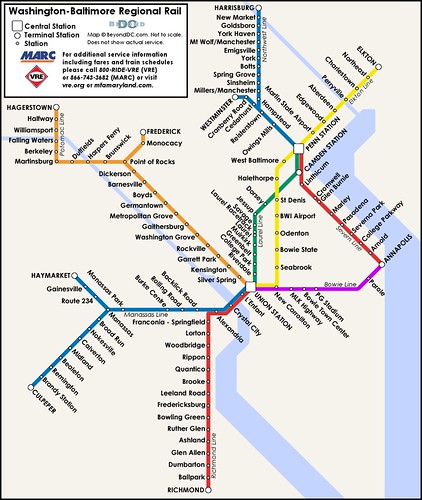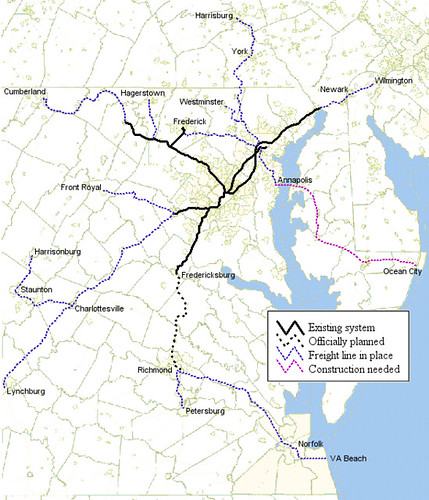Regional transportation planning and fixed rail service
W, in the previous entry, comments that rather than think merely of extending the blue, orange, and yellow lines in Virginia a la the proposed mandate/earmark by Reps. Connolley and Moran (and note that extension of the green line in Maryland, in both directions has been discussed pretty recently also, see "Plan for Metro to BWI Gaining Momentum: Dulles Rail Extension Spurs Md. to Action," "Ulman Pushes Metro Extension to Ft. Meade," and "Prince George's Sees Andrews As Hub of Development" from the Washington Post), that railroad planning expansion needs to be considered as well, indirectly making the point that the subway is better at providing certain kinds of service, and the railroad is better for service farther out.
That is the point of the idea of planning transportation expansion on a wider landscape with a more comprehensive perspective. In this entry, "Second iteration, idealized national network for high speed rail passenger service," I discussed how transportation planning within the U.S. should occur on five distinct but interconnected levels:
- international (connections between countries);
- national (such as the Interstate Highway system or the proposed High Speed Rail Initiative);
- regional or multi-state (freeways sure but also railroads, see below);
- metropolitan such as the subway and bus system for the Washington metropolitan region, which is anchored by the WMATA system and the VRE and MARC railroads; and is supplemented by
- submetropolitan transit networks at the suburban and city levels.
In the past, I have discussed an idea that I think was first proposed by Dan Malouff of BeyondDC (if not the first, Dan's writings were what sparked my thinking about this), of a regional railroad system.
Matt Johnson of Track Twenty-Nine (see "Regional Rail Plan (revised)") has also done some similar conceptualization, focused more on the DC-Baltimore region, rather than Dan's idea of a system for the entire states of Virginia and Maryland, with DC as a significant hub, with connections to West Virginia, Delaware, and Pennsylvania.
And I have been meaning to work with Dan to do a more comprehensive and updated version of his first iteration of the idea.
From a past blog entry:
Create a single railroad system for DC-MD-VA. Rather than having two separate systems oriented to commuters, although Maryland is in the process of transforming the MARC system to a 7 day system, with additional service later in the evening, the region would be best served by one system that is vastly expanded. (Think of the equivalent of the Port Authority of New York and New Jersey but for the railroad system.) And connect MARC to SEPTA.

BeyondDCs conceptual railroad map for one regional railroad system for DC, Maryland and Virginia, including service to parts of West Virginia, Pennsylvania, and Delaware. (Although this particular map focuses on the Baltimore-Washington region.)
I suggest calling this system the RACER, standing for the Railroad Authority of the Chesapeake Region. BeyondDC is working on new maps for this, and is fond of calling the system the Potomac Express. And Greater Greater Washington calls it the MVX, Maryland-Virginia Express. (But they can both do graphic design, and I can't, so they may win out...)

Image by BeyondDC.
Dan has another map showing the potential for railroad service beyond that conceptualized in the map above.

In any case, W's point reiterates mine, that regional and metropolitan transportation planning needs to be appropriately focused on what objectives exist and how to achieve these objectives, rather than focusing on one specific type of transit.
Also see from 2006, "A regional railroad passenger transportation vision for DC, MD, VA, WV and parts of PA."
Labels: fixed rail transit service, railroads, smart growth vs. smarter sprawl, transit, transit and economic development, transportation planning



0 Comments:
Post a Comment
<< Home